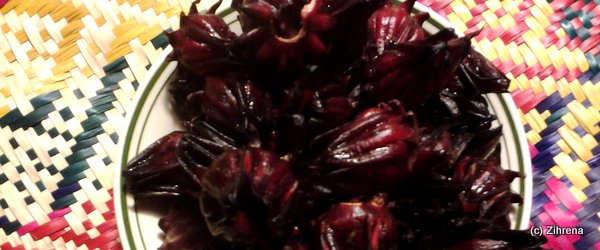Flor de jamaica is the Mexican name for the flowers, or actually the calyces, of the variety of hibiscus known as the roselle, or Hibiscus sabdariffa, which is commonly grown in the tropical climes of the Americas.
Recently, I came across fresh hibiscus flowers at our local Zihuatanejo market. They looked like fleshy, red, organic Christmas decorations, in fact, and I couldn’t resist buying a bag and making a large batch of the sweetened water.
Hibiscus blossoms, often used in commercial tea mixtures, give a distinctive, bright reddish color and a tart, refreshing flavor to herbal blends,
In Mexico, agua de jamaica, or hibiscus water, is prepared as a cold beverage and often accompanies comidas corridas (the traditional Mexican “fast food”), which are in fact more like slow-cooked, home-style meals put together in small, often family-run establishments that cook up a limited choice of standard dishes every day. You seldom know what they’re going to prepare and serve from one day to the next, but you can usually choose from a selection of meat, poultry, fish, and sometimes vegetarian regional cuisine items.Since much of the meal is prepared in advance, the food is served quickly, and the costs are very reasonable, the comida corrida is the meal of choice for employees and townspeople who can’t make it home to lunch.

Fresh hibiscus flowers (jamaica)
Typical comida corrida menus in the area of Zihuatanejo, Mexico, can include things like puerco en salsa verde (pork in green sauce), bistek de res a la Mexicana (Mexican style thin-cut beef), and Tortitas de Coliflor (cauliflower fritters or canapes). The dishes normally are served with a choice of rice or pasta, beans, and tortillas (often hand-made) as well as jug of the fresh agua, and everything is included in the price. Many times, homemade lemonade, agua de tamarindo (tamarind water), or horchata (a sweet rice milk flavored with cinnamon and sometimes vanilla) is served as the agua instead of jamaica.
Whether you buy the dried flowers or the fresh, agua de Jamaica is very easy to make and extremely refreshing. Recently, reports have come out that hibiscus water rates very high in antioxidants (http://www.nydailynews.com/life-style/health/green-tea-hibiscus-based-drinks-pack-antioxidant-punch-article-1.1098463) and may be especially beneficial for controlling cholesterol levels (http://www.news-medical.net/news/2004/09/14/4743.aspx).
The easiest way to make hibiscus water, and one that preserves the most delicate qualities of the flower since it doesn’t use heat, is to place a large handful of dried hibiscus blossoms in a large, three-to-four liter glass or ceramic container (it is said that metals change the taste and other properties of the hibiscus) and cover with filtered drinking water. Allow to “steep” at room temperature for several hours or overnight. You’ll be left with a rich, red, and tart tea without the need to boil the water. Strain, dilute with additional water to obtain the desired strength, add sweetening to taste (preferably raw sugar, honey, agave syrup, stevia, or some other similar and more healthful sweetening agent than regular sugar), and chill.
Hibiscus water is also great blended with other herbs and spices. Try mixing it with mint, ginger, anise, or cinnamon. I make what I call “Hibiscus Chai,” combining hibiscus blossom water with a strong tea made from cinnamon bark, star anise, ginger root, cardamom pods, whole cloves, whole peppercorns, and fresh grated nutmeg (this particular tea, made of so many pieces of bark, roots, and seeds, does need to be brought to the boil and in fact simmered for 15 minutes or more to get the most out of the flavors). The “chai” is wonderful sweetened and mixed with almond or rice milk.